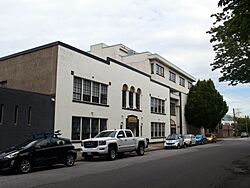Vancouver Japanese Language School facts for kids
Quick facts for kids Vancouver Japanese Language Schoolバンクーバー日本語学校
|
|
|---|---|

Vancouver Japanese Language School
|
|
| Location | |
|
Vancouver, BC
Canada
|
|
| Coordinates | 49°17′03″N 123°05′38″W / 49.2841°N 123.0938°W |
| Information | |
| Established | 12 January 1906 |
| Website | vjls-jh.com |
The Vancouver Japanese Language School (its Japanese name is バンクーバー日本語学校) is a special school. It is located in Japantown, a historic area in Vancouver, British Columbia, Canada. This school is very important because it is the oldest Japanese language school in all of Canada! It first opened its doors way back in 1906. At first, it was called the Vancouver Japanese Citizens' School.
Contents
History of the School
How the School Started
The Vancouver Japanese Language School first opened on January 12, 1906. Its original name was the Japanese Citizens' School. A Japanese diplomat named Marquis Komura Jutarō helped pay for the school to be built.
When it first started, the school taught many different subjects. It followed the Japanese school curriculum. This was a full-time school for Japanese-Canadians living in the area.
Changes Over Time
In 1919, the school changed its focus. It stopped teaching general subjects. Instead, it focused on teaching Japanese-Canadians both English and Japanese. At this time, the school was renamed the Japanese Language School.
Closing and Reopening
A very difficult time came when the Pacific War began on December 7, 1941. The school was forced to close its doors. The next year, many Japanese-Canadians were moved from their homes. This was part of a sad event called Japanese-Canadian internment.
The school building was empty for many years. It did not reopen until 1952. For a short time, the school was held at the Vancouver Buddhist Church. Then, in 1953, it moved back into its original building.
A Special Heritage Building
The school building is located at 475 Alexander Street in Vancouver. It is now recognized as a heritage building by the City of Vancouver. This means it is a very important historical place. It stands as a symbol of the Japanese-Canadian community. It also reminds people of the internment period.
On June 20, 2019, the building was named a National Historic Site of Canada. This is a very high honor! It was recognized for being the oldest and largest Japanese language school in the country. It is also special because it is one of the few times property was given back to Japanese-Canadians after the internment.

